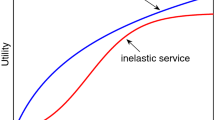Abstract
In peer-to-peer (P2P) networks, each peer acts as the role of client and server. As a client, each peer is regarded as a service customer. It sends requests to other peers to download files and obtains resource allocation from them. As a server, each peer is thought as a service provider. It receives service requests from other peers and allocates its resources to them. To encourage cooperation between peers, fairness is very important in P2P networks since it fosters an incentive to the peers to offer resources to the network. We formulate a fair resource allocation model for P2P networks and investigate the utility optimization problem by Lagrangian method. In order to realize the optimal resource allocation, we present a novel price-based resource allocation scheme by applying the first order Lagrangian method and low-pass filtering scheme, so that a service provider can allocate its resources to its customers based on offered prices, achieving the efficient and fair allocation of the available resources to the serviced customers. Simulation results confirm that the proposed algorithm can achieve the optimum within reasonable convergence times.










Similar content being viewed by others
References
Adamsky, F., Khayam, S. A., Jäger, R., & Rajarajan, M. (2014). Stealing bandwidth from BitTorrent seeders. Computers & Security, 46, 126–140.
Akavipat, R., Al-Ameen, M. N., Kapadia, A., Rahman, Z., Schlegel, R., & Wright, M. (2014). ReDS: A framework for reputation-enhanced DHTs. IEEE Transactions on Parallel and Distributed Systems, 25(2), 321–331.
Analoui, M., & Rezvani, M. H. (2011). Microeconomics-based resource allocation in overlay networks by using non-strategic behavior modeling. Communications in Nonlinear Science and Numerical Simulation, 16(1), 493–508.
Antoniadis, P., Courcoubetis, C., & Mason, R. (2004). Comparing economic incentives in peer-to-peer networks. Computer Networks, 46(1), 133–146.
Bertsekas D. P. (2003). Nonlinear programming. Belmont, MA: Athena Scientific.
Bharambe, A. R., Herley, C., & Padmanabhan, V. N. (2006). Analyzing and improving a BitTorrent network’s performance mechanisms. Proceedings of INFOCOM 2006.
Chen, M., Ponec, M., Sengupta, S., Li, J., & Chou, P. A. (2012). Utility maximization in peer-to-peer systems with applications to video conferencing. IEEE/ACM Transactions on Networking, 20(6), 1681–1694.
Chiang, M., Low, S. H., Calderbank, A. R., & Doyle, J. C. (2007). Layering as optimization decomposition: a mathematical theory of network architectures. Proceedings of the IEEE, 95(1), 255–312.
Dewan, P., & Dasgupta, P. (2010). P2P reputation management using distributed identities and decentralized recommendation chains. IEEE Transactions on Knowledge and Data Engineering, 22(7), 1000–1013.
Eger, K., & Killat, U. (2007). Fair resource allocation in peer-to-peer networks (extended version). Computer Communications, 30(16), 3046–3054.
Elmaghraby, A. S., Kumar, A., Kantardzic, M. M., & Mostafa, M. G. (2005). A scalable pricing model for bandwidth allocation. Electronic Commerce Research, 5(2), 203–227.
Hu, C.-L., & Kuo, T.-H. (2012). A hierarchical overlay with cluster-based reputation tree for dynamic peer-to-peer systems. Journal of Network and Computer Applications, 35(6), 1990–2002.
Kelly, F. P. (2003). Fairness and stability of end-to-end congestion control. European Journal of Control, 9(2–3), 159–176.
Koutsopoulos, I., & Iosifidis, G. (2010). A framework for distributed bandwidth allocation in peer-to-peer networks. Performance Evaluation, 67(4), 285–298.
Krishnan, R., Smith, M. D., & Telang, R. (2003). The economics of peer-to-peer networks. Journal of Information Technology Theory and Application, 5(3), 31–44.
Kumar, C., Altinkemer, K., & De, P. (2011). A mechanism for pricing and resource allocation in peer-to-peer networks. Electronic Commerce Research and Applications, 10(1), 26–37.
Li, S., Sun, W., & Hua, C. (2014). Fair resource allocation and stability for communication networks with multipath routing. International Journal of Systems Science, 45(11), 2342–2353.
Li, S., Sun, W., & Zhang, H. (2014). Fair rate allocation for flows in concurrent multipath communications. Telecommunication Systems, 57(3), 271–285.
Low, S. H. (2003). A duality model of TCP and queue management algorithms. IEEE/ACM Transactions on Networking, 11(4), 525–536.
Mattos, C. L. C., Barreto, G. A., & Cavalcanti, F. R. P. (2014). An improved hybrid particle swarm optimization algorithm applied to economic modeling of radio resource allocation. Electronic Commerce Research, 14(1), 51–70.
Mo, J., & Walrand, J. (2000). Fair end-to-end windows-based congestion control. IEEE/ACM Transactions on Networking, 8(5), 556–567.
Nishida, H., & Nguyen, T. (2010). A global contribution approach to maintain fairness in P2P networks. IEEE Transactions on Parallel and Distributed Systems., 21(6), 812–826.
Qureshi, B., Min, G., & Kouvatsos, D. (2012). A distributed reputation and trust management scheme for mobile peer-to-peer networks. Computer Communications, 35(5), 608–618.
Satsiou, A., & Tassiulas, L. (2010). Reputation-based resource allocation in P2P systems of rational users. IEEE Transactions on Parallel and Distributed Systems, 21(4), 466–479.
Shafiee, Sarjaz B., & Abbaspour, M. (2013). Securing BitTorrent using a new reputation-based trust management system. Peer-to-Peer Networking and Applications, 6(1), 86–100.
Shakkottai, S., & Srikant, R. (2007). Network optimization and control. Foundations and Trends in Networking, 2(3), 271–379.
Song, F., Huang, D., Zhou, H., Zhang, H., & You, I. (2014). An optimization-based scheme for efficient virtual machine placement. International Journal of Parallel Programming, 42(5), 853–872.
Zhang, K., & Antonopoulos, N. (2013). A novel bartering exchange ring based incentive mechanism for peer-to-peer systems. Future Generation Computer Systems, 29(1), 361–369.
Acknowledgments
The authors would like to thank the two anonymous reviewers and the Associate Editor for very detailed and helpful comments and suggestions on this work, and the support from the National Natural Science Foundation of China (No.71301139, No.71101124, No.71271186), the China Postdoctoral Science Foundation (No.2014T70231), the Humanity and Social Science Foundation of Ministry of Education of China (No.12YJC790101), the Research Fund for the Doctoral Program of Higher Education (No.20131333120001), and the Natural Science Foundation of Hebei Province (No.F2013203136, No.G2016203236).
Author information
Authors and Affiliations
Corresponding author
Rights and permissions
About this article
Cite this article
Li, S., Sun, W. A mechanism for resource pricing and fairness in peer-to-peer networks. Electron Commer Res 16, 425–451 (2016). https://doi.org/10.1007/s10660-016-9211-1
Published:
Issue Date:
DOI: https://doi.org/10.1007/s10660-016-9211-1




